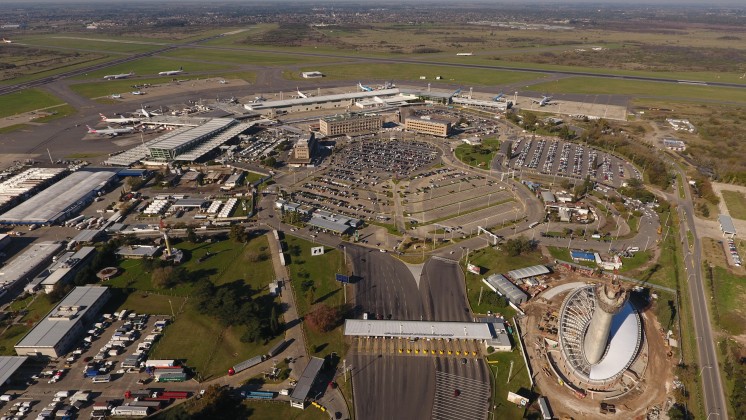By next year’s elections most of the country’s 49 airports will have been renovated and in four years’ time practically all will have had a remake after spending some 30 billion pesos in works. The two most emblematic airports – Ezeiza and Aeroparque – will take longer, in some aspects until the middle of the next decade.
But by mid-2019 (in time for the elections) these two main airports will also have visibly registered major changes.
And where will the money come from? Basically from the passengers and the airlines, whose airport fees feed the trust funds destined for infrastructural improvements . But also since 2016 the concessionaire running most airports, Aeropuertos Argentina 2000 (headed by Eduardo Eurnekian), is multiplying its 2016-19 contractual investment obligations approximately sixfold (see box).
“It’s a record investment because we are using a fund of six bllion pesos left untouched by the previous administration. Furthermore, the concessionaire is contributing to half the works,”said Patricio Di Stéfano, head of the Organismo Regulador del Sistema Nacional de Aeropuertos (Orsna) watchdog. “In less than three years we are making the biggest airport investment since the 60s.”.
Among the works already completed figure Córdoba’s new terminal and Tucumán’s hangar. In Mendoza the runway, the platform, the terminal and the parking-lot were all completely renovated.
The runways and approaches were also renewed in Trelew, Chapelco, Iguazú, Salta and Ezeiza. Furthermore, a new passenger terminal was built in Comodoro Rivadavia, an air traffic control tower and runway in Iguazú and other works in San Juan, Salta and Ushuaia.
New passenger terminals are also under construction in Iguazú and Jujuy, as well as (according to Orsna) in Catamarca, Formosa, La Rioja, Esquel, Tucumán, Mar del Plata and San Fernando, besides renovating the provincial airports of Rosario and Neuquén.
But the hard core of works is concentrated in Aeroparque and Ezeiza, through which 80% of the 28 million passengers last year passed.
In Ezeiza the new air traffic control tower is already far advanced while the old Terminal B has already been decommissioned and demolished.
There the new departures mega-terminal will be built, a building of futuristic design – just this phase of Ezeiza´s renewal will cost 3.2 billion pesos with its inauguration scheduled for June, 2019. At Ezeiza the secondary runway and the pre-embarkment area of Terminal A have also been overhauled.
According to Di Stéfano, in the medium term there will be a building symmetrical to the new departures terminal – it will be the departures mega-terminal, in order to build which Terminal C must be demolished (paradoxically it is the newest, having been inaugurateda by Cristina Kirchner in June, 2001). Terminal A, today the most important in Ezeiza, will be reduced to an auxiliary function for domestic flights.
At Aeroparque there has already been a visible renovation of infrastructure with both the new sector for domestic arrivals and the installation of 20 new check-ins alongside those of Aerolíneas on behalf of Lan). In addition, the covered parking space in the southern building has been doubled.
But perhaps the most important is the inauguration of a new air traffic control tower with new instruments and a visual range five times the previous.
For the next few years works are in line for the north side of Aeroparque: demolition of the current counters for the smaller airlines and the old air traffic control tower, as well as the construction of two new buildings and an underground parking-lot.
Plus a key figure: new positions to park aircraft in the airport with the most traffic in the country. Five more such positions will be added to the current 31 after the demolition of North J. And once a new perimeter has been constructed parallel to the Belgrano Norte tracks, there will be eight more remote positions for a total of 44. There is also a medium-term project to relocate the Costanera avenue on land reclaimed from the river in order to broaden the access roads to Aeroparque. But those ribbons will not be cut until 2021 at the very least.
THE CONTRACT WITH AA2000
Eurnekian betting on more investment for 10 more years
Even if the airports are state-owned, most are under concession, 34 with Aeropuertos Argentina 2000 and another three with the group London Supply. Among the few airports still directly state-run are Neuquén and Rosario.
The concession contract with Grupo América (founded by Eduardo Eurnekian and headed today by his nephew Martín Eurnekian) has been running since 1998 and was renegotiated in 2007 with Néstor Kirchner. It obliges AA2000 to invest an annual 600 million pesos (at updated values) in airport infrastructure, without counting the costs of maintenance.
But as from 2016 AA2000 has generously opened up its wallets despite the lack of any new contract for the moment.
“If there are still 10 years of concession left, the contract provides for the possibility of an extension for another 10”, Martín Eurnekian told this supplement. “If the exponential growth which should have occurred in the past arrives now and in the next few years, we must be prepared with better airports”.
According to Orsna data, between 2016 and this year, AA2000 has already invested 9.34 billion pesos with a further 4.39 pledged for 2019 – in total, over 13.7 billion pesos out of a joint investment with the state of 26 billion in four years (without counting other airports). The AA2000 contribution is almost sixfold its contractual obligations.
“This governmnt has shown a total focus on the aviation industy,” added Eurnekian. “Our role is to accompany those policies, investing in infrastructure as necessary”.
